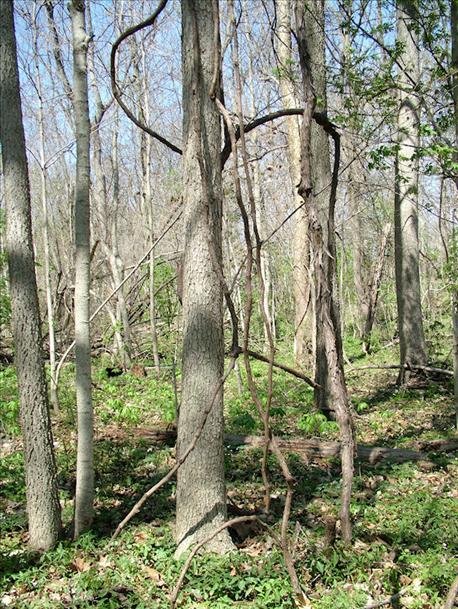January 5, 2016

Woodlands in the eastern U.S. are often a complex mixture of many different types and species of trees, shrubs, vines and other smaller plants. One vine that can create some issues for landowners wishing to grow trees for timber production is grapevine.

A heavy cover of wild grape covering trees and shrubs at a woodland edge. This type of growth may provide important food and cover for wildlife.
There are several native grape species that can be found in eastern woodlands, sometimes in very high numbers. Wild grapes can grow into the very tops of some of the tallest forest trees, often growing up with the tree and spreading through the crown over time. Wild grape can damage trees by covering the leaves of the tree with its own, reducing the growth rate of the tree or even causing death. The weight of grapevines can break branches or cause entire trees to topple under the weight of ice or snow.
Wild grapes have leaves that alternate on the stem and resemble large maple or sycamore leaves. Stems of the wild grape hang free of the tree trunk, unlike poison-ivy and Virginia creeper, which cling to the bark. The larger vines (2 to 12 inches diameter) have brown or rust-colored flaky bark. It clings to branches with thin tendrils that curl and grasp stems.
Wild grape needs full sunlight to continue to grow, so it will tend to climb toward light. On good growing sites, it can grow several feet per year and quickly overtop other vegetation. This can create real problems in tree plantations and young forested areas, where sunlight is available at the surface. Seed bearing grapes are spread by birds into new areas.

Several wild grapevines climb into a young hardwood tree, potentially reducing growth, breaking out branches, or deforming the tree.
Seek control
Woodland owners managing their property for good quality timber production need to control grapevines. Control of grapevines include on trees over 20 feet tall require creating a heavy shaded understory and/or cut the grapevines a few inches above the ground, including any vine loops that emerge and re-enter the soil. These cut stems will sprout, but generally do not survive in the shade.
For young woodlands or plantations with trees less than 20 feet tall, herbicides are required to control re-sprouting. Without herbicide treatment, the vines can rapidly grow back into tree crowns. Cut the vines as described earlier and apply an herbicide that contains dicamba, picloram + 2-4-D, or triclopyr for best results.
This method is effective from summer through early winter. In late winter and spring, sap flow from cut stems will wash off any herbicide applied to the cut. The recommended method is a basal bark application. A triclopyr ester herbicide is mixed with commercially available basal oil, kerosene, or diesel oil at a ratio of 15% to 20% herbicide and 80% to 85% oil and sprayed on the bark of the stem from ground line to 15-18 inches above the ground. The oil carries the herbicide into the vine to kill it without cutting. This method can be used year-round, but is generally more expensive than cut stem treatments. More details on controlling wild grape with herbicides can be found in the Forest Improvement Handbook
If you have an interest in attracting wildlife, particularly birds, to your property, don't kill all your wild grape. Many birds and some other animals relish wild grapes and use the vine bowers for cover and nesting. Some birds use the fibrous bark for building nests. Keep some wild grape on the edge of your woodlands, or along streams or other water bodies for wildlife habitat.
Wild grape can be bad, good, or both depending on our property management goals and where it grows.
Information for this article was provided by Lenny Farlee, Extension Forester, Purdue University. Fredric Miller is a horticulture professor at Joliet Junior College, and a senior research scientist in entomology at The Morton Arboretum in Lisle, Ill. Email your tree questions to him at [email protected].
You May Also Like




